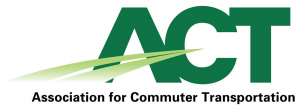People love the convenience and comfort of their solo-driven, single occupant vehicles. Convincing them that ridesharing, bicycling, public transit, or biking could be smarter choices is an uphill challenge.
Educational initiatives and awareness-raising campaigns are helpful, but often aren’t enough to convince commuters to try something different.
Often it’s necessary to use tangible incentives to get people to step outside of their comfort zones.
The EPA acknowledges the effectiveness of economic incentives when trying to change commuter behavior. Transit pass subsidies, vanpool provisions, alternative commute subsidies, and transportation allowances all have a proven track record. Therefore, organizations that want to establish smarter commuting patterns but aren’t using any sort of incentives program can stand to see a huge boost in participation and effectiveness by doing so.
As one way of giving back to the transportation demand management (TDM) industry and supporting our clients, RideAmigos is creating easy-to-follow TDM recipes for success. While these are best implemented using the powerful RideAmigos platform, the basic steps can easily be adapted to fit most any organization.
The following recipe is adapted from the “Smarter Commuting Financial Incentive Soufflé” recipe found on the RideAmigos Academy:
How to Create Financial Incentives for Alternative Commuting
1) Educate commuters about available options
What options are easily accessible to people in your company or area? Options like ridesharing, vanpools, public transit, bicycling and even walking are often available, but are sometimes not ideal options depending on context. Learn which options your audience is most likely to use, then begin with an educational campaign to make sure these options are widely known.
2a) Decide the parameters of your incentive
Typically incentives are given to users who complete a certain number or percentage of non-single-occupant-vehicle (non-SOV) commutes over a particular time period. Sometimes particular methods of transportation are highlighted, such as carpooling or biking. Financial incentives for meeting the designated criteria can take numerous forms. Some ideas include gift certificate for use at local shops or online, free transit passes, or even cash bonuses.
2b) Determine how you will will track & distribute
Once you’ve selected the qualification criteria and reward for your incentive, you need to determine how to track user participation and incentive redemption. You could use an online spreadsheet or database, but the easiest solution is using specialized TDM software like RideAmigos. Using our built-in incentive management tools makes tracking participation and redemption simple.
3) Encourage people to sign up for the incentive, log their trips, and claim their prize
Now that your commuters know their options and you’ve set up your system, it’s time to get users to sign up. Ideally you can use the same marketing and communication methods you used in step 1 to spread the word about your program. Have users sign up and begin tracking their non-SOV commutes. Again, this is made easier by RideAmigos using our commuter dashboard and features like automatic commute logging. Once they’ve reached the goal they can request to redeem their reward.
4) Review the progress of the users who have claimed their incentive
Just because a user claims to have completed the necessary steps to receive your incentive doesn’t necessarily mean they’ve done so. Be sure you’ve included a method to double-check that they have complied with your program’s criteria! With RideAmigos it’s easy to confirm whether a user’s trips match your parameters.
5) After verifying the trips of users who have claimed their incentive, approve or deny their requests
You’ll need to have a plan for communicating whether incentive claims have been approved or denied. This is especially important if you need to explain why a request was denied. Clear communications of expectations is a key step to success.
6) Distribute your financial incentives to those who have been approved
Incentive distribution may involve electronic rewards, physical delivery, or even collaborating with your payroll department. Once participant’s claims are approved, set your system into motion to make sure they receive their rewards.
7) Evaluate, adapt, and repeat
Once you reach the end of your incentive period, evaluate your users’ levels of participation and completion. You might want to survey participants to get their feedback to improve future programs. Once you know what worked well and what didn’t you can make alternations to your program and prepare to run it again. Some organizations even choose to provide such smart-commuting incentives year-round!
Additional Resources:
Did you know? Employers can receive tax benefits for offering employees financial benefits that encourage commuting using alternative modes of transportation (PDF)
The Victoria Transport Policy Institute has an excellent and detailed write-up on commuter financial incentives.

 We’re also excited to announce that the Association for Commuter Transportation is sponsoring CommuteCon. Please join us in saying “thanks!”
We’re also excited to announce that the Association for Commuter Transportation is sponsoring CommuteCon. Please join us in saying “thanks!” On April 1st the annual
On April 1st the annual